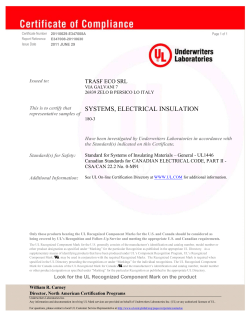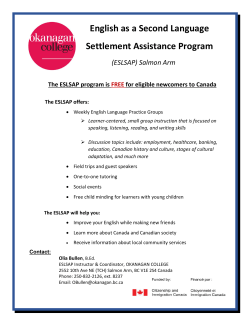
The US Economy: Back to the New Norm
CIBC World Markets Inc. Economic Insights—June 25, 2015 Rich Loonie to Slow Poloz Nick Exarhos and Avery Shenfeld Oil’s tumble has brought the Canadian dollar down with it. But our currency is still richer than it may look. A careful analysis of macro linkages suggests that, when adjusted for the deterioration in trade fundamentals and rate spreads, the currency is posing a meaningful drag on growth. That’s tantamount to tighter overall monetary conditions than are conveyed by looking at interest rates in isolation. Look for overall monetary conditions to be brought into better alignment as the Fed hikes and the Bank of Canada stands pat, allowing the loonie to stay grounded even as oil recovers. A main driver of that movement in favour of the value of Canadian exports was robust energy prices. However, when comparing the time before and after the Great Recession, it took less from oil for the Canadian dollar to trade near, and through, parity versus the greenback (Chart 1, right). Furthermore, the loonie’s resiliency was even more impressive since non-oil commodity prices were also weaker post crisis—namely lumber, natural gas, and most metals—while the C$ traded through prior cycle highs. That suggests that even when accounting for the strength of commodity prices, including oil, other factors were at play in lifting the currency, including safe haven flows during, and in the aftermath of, the financial crisis. Canada: A Currency Sensitive Nation Canada is one of the most open G7 economies, with its 30% share of exports to GDP second only to Germany. And while Germany sends its outbound shipments largely within the Eurozone, making it less sensitive to currency fluctuations, Canada benefits from no such buffer. That’s why the competitiveness of our non-resource exports is particularly vulnerable to the strength in the Canadian dollar. The loonie was powered by the most dramatic, positive terms of trade shock amongst the G7 (Chart 1, left) since 2005, when OECD estimates placed the Canadian dollar at fair value. A symptom of the deviation from fundamentals can be seen in the trade data. Though oil prices held onto levels that were not that far from the pre-recession peaks, the Canadian trade balance was a few billion dollars lower than it was before (Chart 2, left). That deterioration was primarily led by the ex-energy balance, which has been on average $6 billion dollars weaker in the current recovery (Chart 2, right). While Canadian GDP held its own relatively well through that period—especially compared to some of the weaker G7 members—it leaned heavily on housing and debt-financed consumption. And we know that those trends won’t go on forever. Chart 1 Chart 2 CDA Experienced Positive Terms of Trade Shock (L); But Less Required From WTI for Higher Altitude (R) Trade Balance in Red Despite Higher Crude (L); Driven by Non-Energy Deterioration (R) $/bbl 100 95 85 90 2005 2006 2007 2008 2009 2010 2011 2012 2013 2014 75 Cda Japan Ger USA 100 4 80 2 0 60 0 40 -2 -1 20 -4 Pre-Crisis WTI (US$/bbl, L) Trade Bal ($ bn, R) Post-Crisis Source: OECD, Bloomberg, CIBC 2 Non-Energy Trade Balance (monthly avg, C$ bn) 1 -2 -6 -3 0 85 80 6 Jan-00 80 120 Jul-13 90 8 Jan-09 95 140 Apr-11 100 10 Oct-06 105 105 160 Jul-04 110 Avg WTI Price When C$>95 US-cents Apr-02 Terms of Trade (2005=100) 115 -4 -5 -6 '00-'08 '09-Today Source: Statistics Canada, CIBC 3 CIBC World Markets Inc. Economic Insights—June 25, 2015 How Rich is the Loonie? Chart 4 Rich Loonie Equivalent to Tighter BoC Policy In an effort to uncover what “fair value” would be for the Canadian dollar given underlying drivers, we’ve constructed a regression model incorporating energy prices, non-energy commodity prices and interest rate spreads. Other popular methods use error-correction models, which try to measure the dynamics of the C$’s trading, and how quickly the currency re-establishes the short-run equilibrium. Our model instead derives a fair value on the currency given its historical relationship with its underlying drivers, on a real basis. The analysis suggests that since 2009, the C$ has been trading roughly 10% rich versus fundamentals since the end of the recession (Chart 3). Bank of Canada Avg Overnight Rate (%) 7 6 5 4 ~90 bps tighter 3 2 1 0 Q1-00 Q3-02 Q1-05 Q3-07 Q1-10 Actual Q3-12 Q1-15 Equivalent Source: BoC, CIBC Given that Canadian growth is in part driven by the interest rate setting, and in part due to the exchange rate (especially since Canada is an open economy), we can determine output sensitivities to both those factors. As we model Canadian aggregate demand using interest rates and the Canadian dollar, we can establish the tradeoff between an overvaluation in the currency and the equivalent boost to the overnight rate. We also measured the sensitivity of growth to both interest rates and the degree to which the Canadian dollar was overvalued due to exogenous factors. the currency to the overnight rate, which would have suggested a dramatic 3% lift to the monetary setting. Given that we spent over 70% of the time since 2009 with core CPI under 2%, it shouldn’t be a huge surprise that our analysis suggests that monetary conditions have been tighter than the BoC’s official rate. In an effort to keep the Canadian dollar trading well beneath parity, while at the same time counteracting the implied effects on monetary policy that the currency has provided, expect the BoC to be much more patient than the Fed, with short end rate spreads between the two nations closing (Chart 5, left). A less turbulent global environment, along with the elimination of the short rate advantage will cause the premium placed on the C$ to also narrow significantly by the end of 2016 (Chart 5, right). Taken together, those models imply that the loonie’s richness was equivalent to roughly 90 bps of tighter BoC policy since the start of 2009 (Chart 4). That’s lower than what we would have estimated using the Bank of Canada’s once widely used monetary conditions index. The BoC’s index had a roughly 3 to 1 tradeoff between Chart 3 Chart 5 CIBC Fair Value Model Points To Significant C$ Overvaluation BoC Will Lag Fed (L), Helping Premium Dissipate from Currency (R) Difference in Effective O/N Rates (Can-US, bps) 100 fcst 80 60 Mar-16 Sep-16 Mar-15 Sep-15 Sep-14 Jun-16 Dec-14 Sep-15 Jun-13 Mar-14 Dec-11 Sep-12 Mar-11 Mar-14 70 -20 4 90 75 0 Source: Bloomberg, Statistics Canada, CIBC fcst 95 80 20 CIBC Model US-cents/C$ 100 85 40 CADUSD 105 Mar-13 Avg 9.5% Overvaluation Sep-13 US-cents/C$ Mar-01 Dec-01 Sep-02 Jun-03 Mar-04 Dec-04 Sep-05 Jun-06 Mar-07 Dec-07 Sep-08 Jun-09 Mar-10 Dec-10 Sep-11 Jun-12 Mar-13 Dec-13 Sep-14 110 105 100 95 90 85 80 75 70 65 60 CADUSD CIBC Model Source: Bloomberg, CIBC
© Copyright 2025













